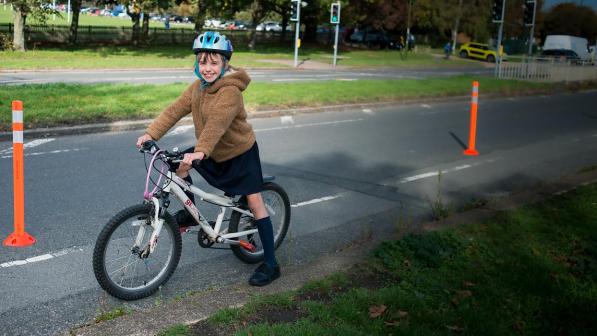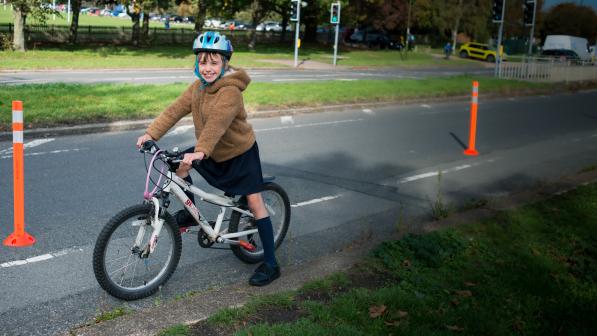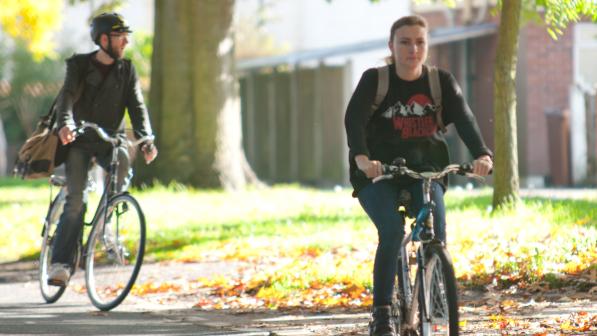Irrational and unlawful removal of a cycle lane: FAQs

On 24 February, Cycling UK applied to the High Court for a judicial review challenging a decision made by West Sussex County Council on 25 November 2020 to remove a cycle lane along the A270 Upper Shoreham Road in Shoreham.
The answers to the following FAQs should hopefully give the background to what happened in Shoreham, why Cycling UK is doing this, and what this case is all about.
What is judicial review?
Judicial review is a court process where a judge reviews the lawfulness of a decision or action by a public body, in this case the council, challenging the way in which a decision has been made.
What are Cycling UK asking the court to do?
Cycling UK is asking the court to make a declaration that the council’s decision to remove the cycle lane was unlawful, to quash (overrule) that decision, and to make an order requiring the council to consider reinstating the lane.
How long will this take?
When a claim for judicial review is submitted, the court has to first consider whether to grant permission to allow the case to proceed to a full hearing. The test at the permission stage is whether the grounds on which the case has been brought are arguable, so the court can eliminate claims with no prospect of success.
We can’t be certain of timescales, but hope that the court will grant permission before the end of April, with the case proceeding towards a full hearing in the autumn.
How was installation of this cycle lane funded?
On 9 May 2020, Transport Secretary Grant Shapps announced what he described as a package of measures to put cycling and walking at the heart of transport policy in England. They included an emergency active travel fund (EATF), and on 27 May, the Department for Transport (DfT) wrote to local authorities outlining provisional funding allocations of £225 million, to be released in two phases (or tranches) to enable local authorities to “act now to embed walking and cycling as part of new long-term commuting habits”.
The council installed this cycle lane through funding from the EATF.
What funds did the council apply for from the EATF?
On 5 June 2020, the council applied for funding from the EATF, including estimated costs of £170,200 to install the cycle lane at Upper Shoreham Road.
On 26 June the council was awarded £782,00 from tranche 1 of the EATF to install seven new cycle lane schemes, including the Upper Shoreham Road lane, with an expectation that the facilities would be available for use by the end of September 2020.
When did the council install this cycle lane?
The council started work to install the lane on 7 September 2020. It announced that it was completed on 25 September, although additional works were still being undertaken on the lane throughout October. The cycle lane scheme was around 95% complete by the time the council considered the removal of the lane on 3 November.
When was the decision taken to remove the cycle lane?
The Cabinet Member for Highways and Infrastructure took the decision to remove all seven EATF schemes in West Sussex on 3 November 2020. The council’s constitution allows such decisions to be taken by a cabinet member subject to call-in, which means that a decision is not final until the period for call-in by the relevant scrutiny committee has passed.
The decision was called in and considered by the scrutiny committee on 18 November. The committee noted that the Upper Shoreham Road cycle lane had exceeded expectations, that it was questionable why a successful scheme should be removed and asked whether the temporary scheme could be retained whilst a permanent scheme was prepared.
The committee also recommended that the Cabinet Member should reconsider his decision, but on 25 November the Cabinet Member confirmed his original decision to remove the cycle lane.
When was the cycle lane removed?
A small section of the lane was removed in the week commencing 11 January 2021, with the rest of the lane removed by the end of January.
Did people use the cycle lane?
Information regarding cycle use during the five week period to 1 November was set out in a council officer’s technical report and repeated in a report by the Director of Highways, Transport and Planning dated 18 November 2020. This showed a significant increase in the number of cyclists using the road, from 800 cycle movements a week to 2,000.
Did the cycle lane cause other problems?
The officer’s technical report showed that following installation of the lane there was no increase in air pollution, average drive through times remained the same (so no increase in congestion), the emergency services had no concerns, and the scheme had the highest number of positive comments for any EATF scheme the council installed.
The report also highlighted that negative comments focussed on safety and delays, neither of which were supported by other data, and reduction in residential parking.
On what grounds are Cycling UK seeking a judicial review?
Cycling UK believes that the council failed to have regard to or comply with statutory guidance, acted irrationally given that its own information did not support the reasons given for the removal of the lane, and breached the public sector equality duty (see below), with information available to it that the lane was especially beneficial to children accessing local secondary schools.
What statutory guidance should the council have had regard to?
Highways authorities have a ‘network management duty’ under the Traffic Management Act, and that Act also obliges traffic authorities to comply with statutory guidance when performing their network management duties.
When the government announced the EATF it also published new statutory guidance. Whilst there have been variations to that guidance subsequently, the key element of that guidance has remained the reallocation of road space to people waking and cycling, both to encourage active travel and to enable social distancing.
What is the public sector equality duty?
Under section 149 of the Equality Act 2010, when making decisions, public authorities are required to have due regard to the need to do various things. This is known as the public sector equality duty (PSED), and it includes the need to advance equality of opportunity between people who share a relevant protected characteristic and people who don’t. Age is a protected characteristic under the Act.
What did the council say about equality?
The council did not carry out any equality impact assessment in making the decision to remove the lane, merely stating that this had no implications in terms of the equality duty, despite knowing that the lane was especially beneficial to parents and children for school access in addition to students at local secondary schools.
The council failed to carry out any PSED impact assessment on the basis of age (or any other protected characteristic, such as disability), and decided to remove the scheme because of complaints by motorists, a much older age-group, without consideration of the equality impact on young people.
How is Cycling UK funding this case?
Cycling UK has designated funds, known as the Cyclists’ Defence Fund (or CDF), which it uses to help fight significant legal cases involving cyclists and cycling, especially those which could set important precedents for the future. Cycling UK is using this fund to pursue this case.
How can I help Cycling UK pursue cases like this?
You can help Cycling UK pursue cases like this by donating to Cycling UK’s Cyclists’ Defence Fund. Your donation will go towards our designated legal fund, set aside as a ‘fighting fund’ for legal action and cases.



